As you are transitioning out of the military and into the civilian workforce, you are probably starting to create your resume. If not, it may come as a surprise when you get to the end of the application and have to upload one. For those who have never written a resume or haven’t written one in a while, here are some do’s and don’ts.
Here are 5 resume tips for troops getting out of the military
1. Don’t put your address

If you have not written your resume in a while or are following a template, you may be inclined to list your entire address. Resist the urge to do so. Prospective employers do not need your entire address, nor is that something included on resumes anymore. Besides, many jobs these days are remote. If you want to show that you will be in the local area after you leave the service, you can include City, State. For example, if you are ETSing from Fort Liberty and are looking to move to Dallas, you could put “Dallas, TX” on the top part of your resume. Still, you don’t have to include a City, State on your resume; it is not a requirement.
2. Don’t use a resume template

Speaking of templates, don’t use them. It is easy to search Microsoft Word, Apple Pages or Google Docs to find all sorts of resume templates. While you want to make resume writing easier, this is not in your best interest. Using a template does not mean your resume will be read in an Applicant Tracking System (ATS). You may be familiar with this term if you have taken your TAP classes. ATS is a computer software program that sorts and ranks applicants by comparing the job posting to submitted resumes. Resume templates are not usually formatted in ways that are easy for an ATS to read. Most of the time, they also do not maximize space and are more difficult for employers to scan and identify key pieces of information. If you want to ensure your resume will get read correctly and sorted appropriately in the ATS, hand-type your resume. Use an eye-friendly font like Arial, Calibri or Verdana and black text only. Stay away from color and “cute” blocks of content and icons.
3. Do create a “Summary of Qualifications”

Do you have a section at the top of your resume that tells the employer why you are qualified for the job and/or industry? If not, you need to create a summary of qualifications. This is a section under your name block that speaks to the why: why you are qualified and why you are the perfect person for the job. This section may be labeled with headings such as: “Summary of Qualifications,” “Executive Summary,” or “Professional Summary.” This can be written as a paragraph, bulleted list, or a mixture of the two. Depending on importance, you may create a credentials or skills section within this piece.
4. Do consider your email address

Do not put a .mil email address on your resume. That aside, what civilian email provider do you use? Did you know that it could date you (looking at the Hotmail, AOL, MSN, Yahoo, and iCloud users)? Consider using a modern email provider like Gmail or Outlook. Looking at the email address, be aware of any numbers used. Two-digit numbers may appear to show the year you were born and/or your age when you created the account. Prospective employers do not need to know you were born in 1980 if your email is firstlast80@yahoo.com.
5. Target your resume

Remember the Applicant Tracking System, the ATS? This is what you need to do to get to the top of the sorting list: target your resume to the job posting using the language and skillsets outlined in it. If you’re going to a job fair, target the resume to what you want to do and the industry you are looking to get into. Use terminology that is industry-friendly and that you may have found while going through job postings. An employer does not want to see your entire work history and everything you’ve done, but what you have done that’s relevant to what you are applying for. Your resume should be two pages maximum.
If you find yourself wanting to know more about resumes and how to write them, there are several resources out there for transitioning military, military spouses, and veterans including Department of Labor TAP, Off-Base Transitioning Training resume workshops for veterans, resume workshops for military spouses. RecruitMilitary also offers Monday Resume Webinars.


